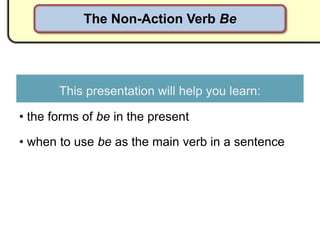How We Use be
•
6 gostaram•2,017 visualizações
This presentation explains how we use "be" as the main verb in a Present tense English sentence.
Denunciar
Compartilhar
Denunciar
Compartilhar

Recomendados
Recomendados
Mais conteúdo relacionado
Mais procurados
Mais procurados (20)
Destaque
Destaque (19)
Transformations in Transformational Generative Grammar

Transformations in Transformational Generative Grammar
Semelhante a How We Use be
Semelhante a How We Use be (20)
What is an Adverbial Phrase Types & Format with Examples.pdf

What is an Adverbial Phrase Types & Format with Examples.pdf
Último
Making communications land - Are they received and understood as intended? webinar
Thursday 2 May 2024
A joint webinar created by the APM Enabling Change and APM People Interest Networks, this is the third of our three part series on Making Communications Land.
presented by
Ian Cribbes, Director, IMC&T Ltd
@cribbesheet
The link to the write up page and resources of this webinar:
https://www.apm.org.uk/news/making-communications-land-are-they-received-and-understood-as-intended-webinar/
Content description:
How do we ensure that what we have communicated was received and understood as we intended and how do we course correct if it has not.Making communications land - Are they received and understood as intended? we...

Making communications land - Are they received and understood as intended? we...Association for Project Management
Último (20)
On National Teacher Day, meet the 2024-25 Kenan Fellows

On National Teacher Day, meet the 2024-25 Kenan Fellows
ICT Role in 21st Century Education & its Challenges.pptx

ICT Role in 21st Century Education & its Challenges.pptx
Making communications land - Are they received and understood as intended? we...

Making communications land - Are they received and understood as intended? we...
Jual Obat Aborsi Hongkong ( Asli No.1 ) 085657271886 Obat Penggugur Kandungan...

Jual Obat Aborsi Hongkong ( Asli No.1 ) 085657271886 Obat Penggugur Kandungan...
Asian American Pacific Islander Month DDSD 2024.pptx

Asian American Pacific Islander Month DDSD 2024.pptx
How We Use be
- 1. The Non-Action Verb Be This presentation will help you learn: • the forms of be in the present • when to use be as the main verb in a sentence
- 2. Present of Be: Statements
- 3. Present of Be: Contractions
- 4. Present of Be: Negatives
- 5. Word Order with Be When be is the main verb in an English sentence: • the subject comes first. The subject is whom or what we’re talking about. • the verb be (am, is, are) comes second. The verb must agree with the subject! • the complement completes the sentence. The complement is an adjective, a noun, a prepositional phrase, or a combination of these.
- 6. Word Order with Be Subject be complement I am hungry. (adjective) She is my classmate. (noun) They are from Mexico. (prepositional phrase)
- 7. When Do We Use Be? In English, we use the verb be when we: • tell time. • talk about the weather. • give someone’s age • give the place of origin • give a location • describe someone or something • classify someone or something
- 8. When Do We Use Be? In English, we use the verb be when we: • tell time The subject is always it. Examples: What time is it? It is one o’clock. It’s 3:30 now.
- 9. When Do We Use Be? In English, we use the verb be when we: • talk about the weather. The subject is it. The complement is an adjective. Examples: What’s it like outside? It is warm and sunny. It’s not rainy.
- 10. When Do We Use Be? In English, we use the verb be when we: • give someone’s age Don’t use have as you do in some other languages. Use just a number or a number with years old. Examples: How old are you? I’m twenty years old. or I’m twenty. Wrong: I’m twenty years.
- 11. When Do We Use Be? In English, we use the verb be when we: • give the place of origin Use the preposition from. Examples: Where is he from? He’s from New York. Brie cheese is from France.
- 12. When Do We Use Be? In English, we use the verb be when we: • give the location of someone or something The complement is a prepositional phrase. Examples: Where is the library? It’s on Lee Highway. The flowers are in a vase on the table. Where are your children? They’re at the park.
- 13. When Do We Use Be? In English, we use the verb be when we: • describe someone or something Use adjectives as the complement. Examples: This man is bald. His eyes are brown. He’s young and handsome. He’s very intelligent.
- 14. When Do We Use Be? In English, we use the verb be when we: • classify someone or something Use nouns in the complement to say what or who the subject is. Examples: This is a laboratory. It’s a very clean room. Those men are scientists.